ASUS Dynamic OC Switcher allows dynamic switching between AMD Precision Boost Overdrive and OC mode on AMD Ryzen processors.
ASUS Dynamic OC Switcher Overview
Dynamic OC Switcher, or DOS for short, is ASUS’ clever way of addressing a core challenge when overclocking AMD Ryzen processors. It was first introduced with the ASUS ROG Crosshair VIII Dark Hero motherboard and has since been included in several other ASUS motherboards.
As we know from the Raphael launch article, there are two approaches to AMD Ryzen CPU core overclocking: Precision Boost Overdrive and OC mode.
- Precision Boost Overdrive has the benefit of retaining all the automatic boost algorithms, including the peak single thread frequency and associated performance.
- OC Mode has the benefit of enabling precise per-CCX fine-tuning for the maximum stable all-core frequency.

So, you typically have to choose to compromise either the best single-threaded performance or the best multi-threaded performance.
ASUS Dynamic OC Switcher gives us the best of both worlds, allowing the system to actively switch between Precision Boost Overdrive and manual OC Mode. It’s most easy to conceptualize DOS as retaining all automatic Precision Boost benefits but with a manually configured frequency floor for all-core workloads.
ASUS Dynamic OC Switcher Configuration Example (Ryzen 7 7700X)
Example from SkatterBencher #47.
DOS requires little additional configuration work. We need to know two things:
- What is the lowest frequency we will allow
- At which point do we want DOS to switch between PBO and OC Mode
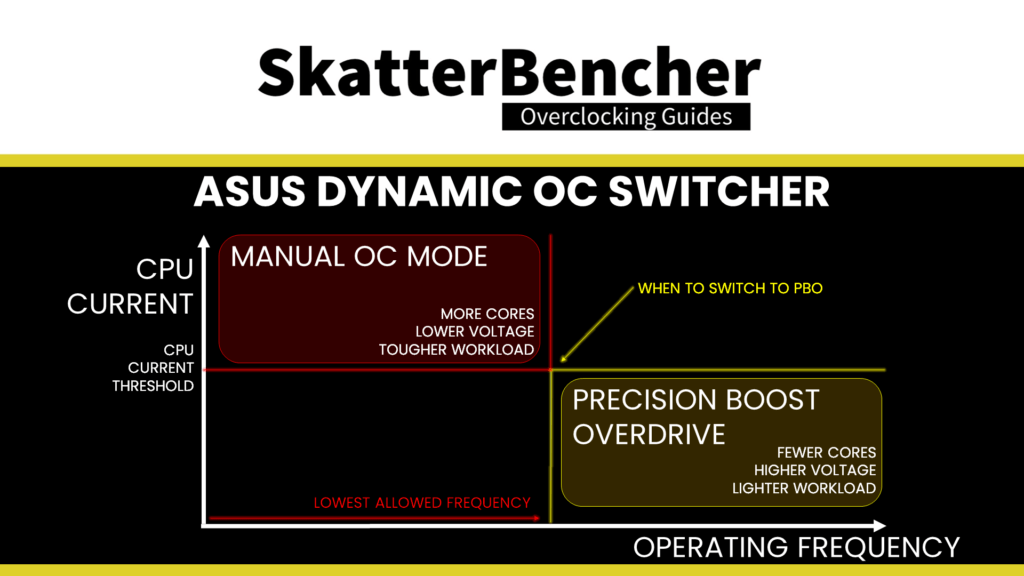
Sadly, we cannot simply configure a minimum frequency and have the system switch based on that. Instead, we need to use a proxy metric: a specific current or temperature threshold. There is no perfect method of determining the ideal threshold, so I’ll show you one example using Prime95 Small FFTs without AVX.
The first step is to determine your desired manual overclock. The fastest way to get to this point is by first selecting your stress test tool of choice and finding the maximum CPU voltage within your thermal budget. Afterward, find the maximum stable frequency for that voltage and temperature. In our case, we can rely on our overclocking settings from OC Strategy #5
- Stress Test: Prime95 non-AVX
- OCVID: 1.275V (1.215V under load)
- CCX0 Ratio: 53.50
We can write the settings down and switch back to tuning with Precision Boost Overdrive. The next step is to apply all your Precision Boost Overdrive tuning settings, including any custom Curve Optimizer or Fmax Override settings.
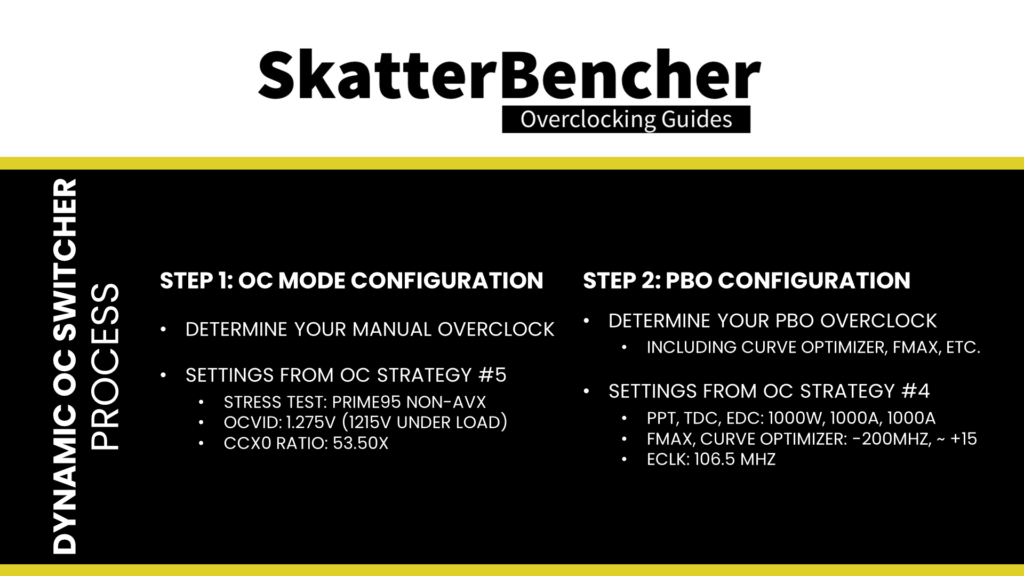
Then, go into the operating system and open your stress test tool and HWiNFO. We aim to find when the Precision Boost frequency drops below our target manual overclock of 5350 MHz and check the current use. In HWiNFO, we will monitor the CPU Core Effective Clocks and ASUS EC VRM Vcore Current.
Then we start the Prime95 non-AVX stress test and change the affinity to 1 thread in Task Manager. Now monitor the core clock frequency. It will be higher than our target of 5350 MHz. Now you can gradually increase the active thread count. When you reach 5350 MHz or below, check the ASUS EC VRM Vcore Current reading. This value will be our input for the DOS Current Threshold setting. In my case, we reach the frequency of 5350 MHz at 9 active threads and the current reads about 70A. This will be our Current Threshold value for Dynamic OC Switcher.
So, to reiterate what’s happening: Dynamic OC Switcher will actively switch between OC mode and Precision boost when the CPU current hits 70A. Anything above 70A engages manual OC mode; anything below 70A will engage Precision Boost.

But one last and important note!
Our Precision Boost Overdrive ECLK OC strategy includes an adjusted ECLK frequency of 106.50 MHz. When Dynamic OC Switcher switches between PBO and OC mode, it does not change these settings. So, we must adjust our manual overclock settings accordingly:
- CCX0 Ratio from 53.50 to 50.25
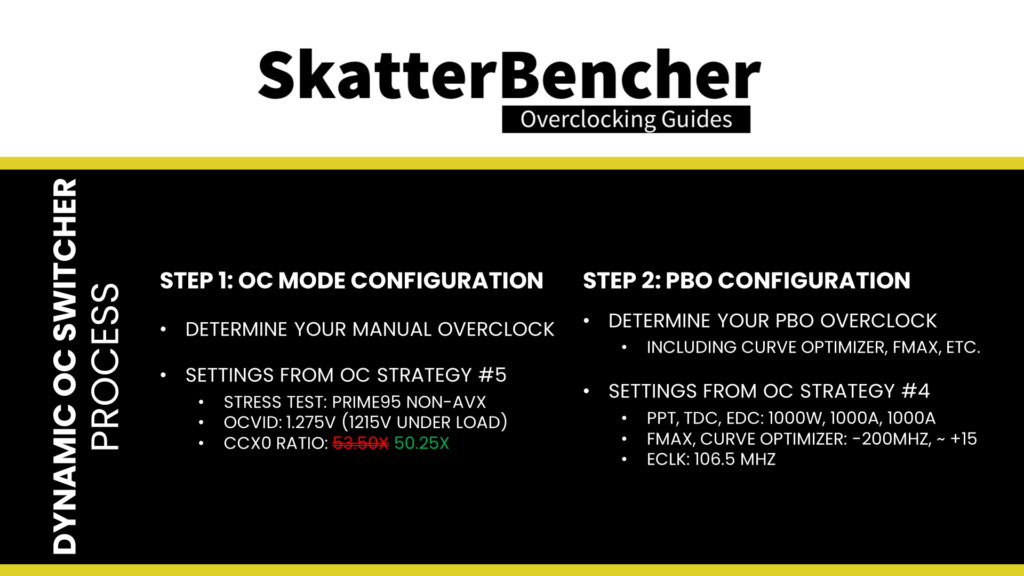
ASUS Dynamic OC Switcher Configuration Example (Ryzen 9 5950X)
Example from SkatterBencher #15.
The exact trigger point will depend on your CPU, your motherboard, your cooling, and your system. One way of identifying the right trigger point is to check the CPU current during a benchmark workload. I’ll give you an example.
First, make sure the system is set to default settings with Precision Boost Overdrive enabled. Then go in the Operating System, you can use HWinfo and Prime 95 without AVX. Gradually increase the amount of Prime 95 threads until you see the operating frequency drop below your desired manual overclock. When this happens, check the CPU current in HWinfo. This is the value you can use to configure DOS OC.

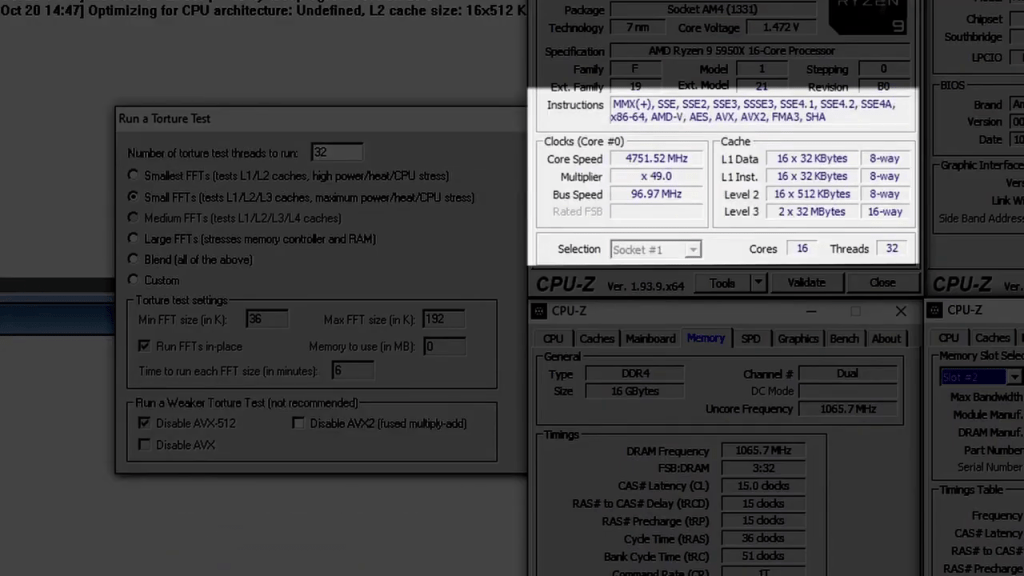
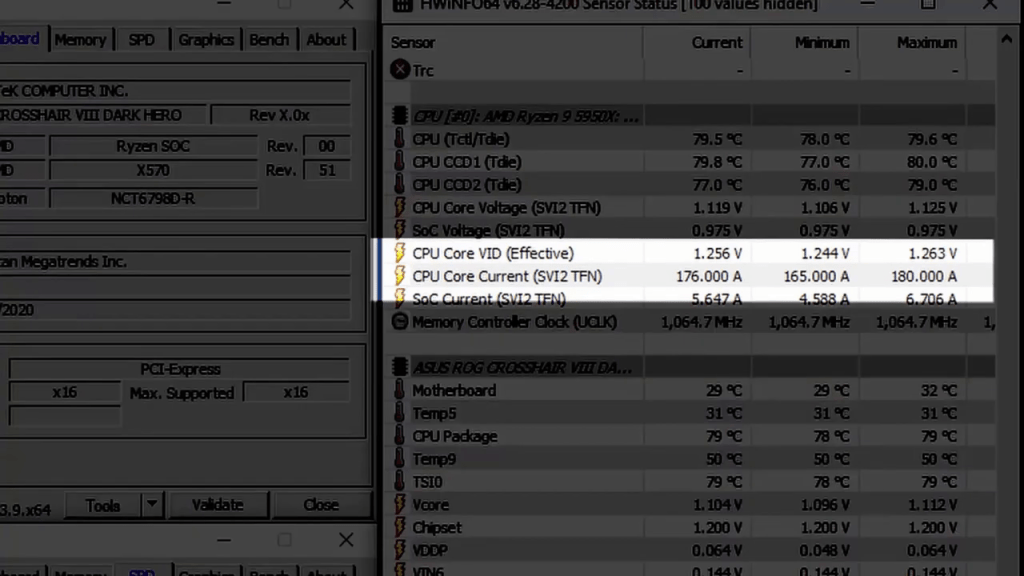
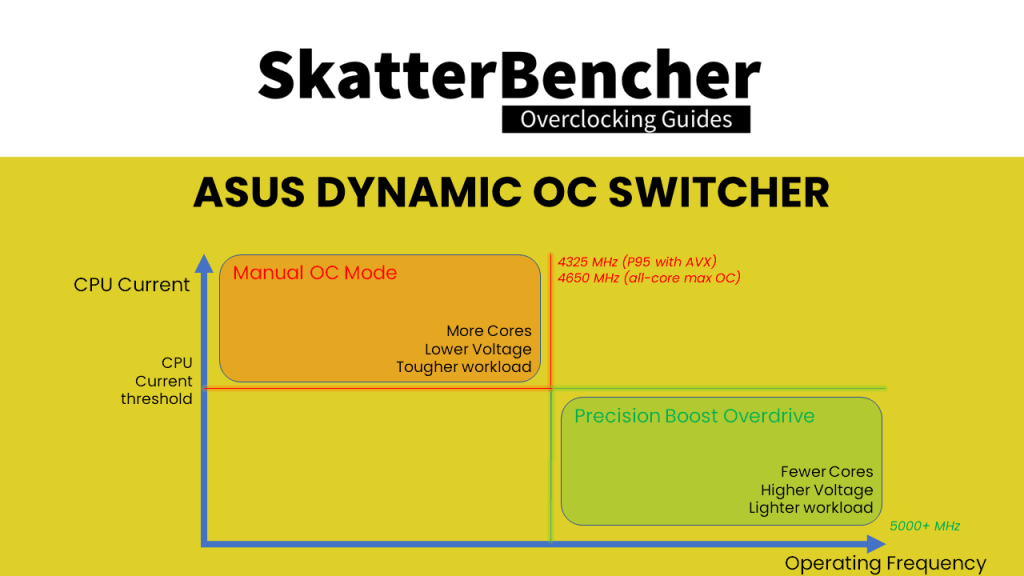
As a rule of thumb, you should expect a high manual overclock to have a low current threshold and vice versa.
ASUS Dynamic OC Switcher Configuration Example (Ryzen 9 5900)
Example from SkatterBencher #29.
For our minimum frequency, we choose our maximum stable manual overclock. I verified the maximum stable manual overclock of this CPU using Prime 95 Small FFTs with AVX disabled and ended up with a ratio of 46.25 for CCD0 and 45.50 for CCD1 with a core voltage of 1.345V. So, our minimum frequency will be the average of 4625 and 4550 MHz, so 4587 MHz.
In the Operating System, we first open HWiNFO. We make sure we can monitor both the Effective Clock Frequency and the CPU Core Current.
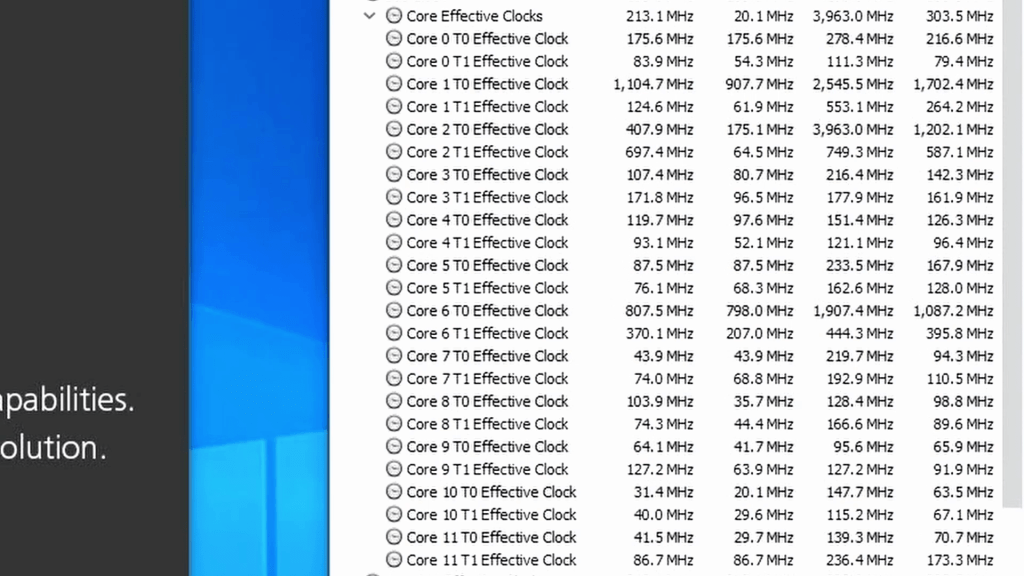
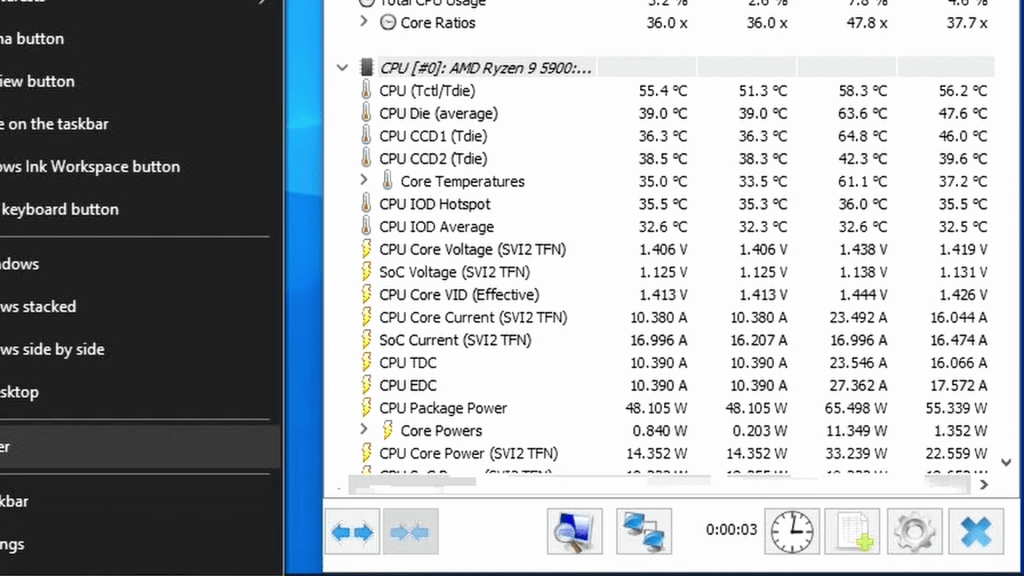
Then we start the Cinebench R23 multi-threaded benchmark workload and change the affinity to 1 core in task manager. Now monitor the effective clock frequency. It will be higher than our target of 4587 MHz. Now you can gradually increase the Cinebench R23 thread count.
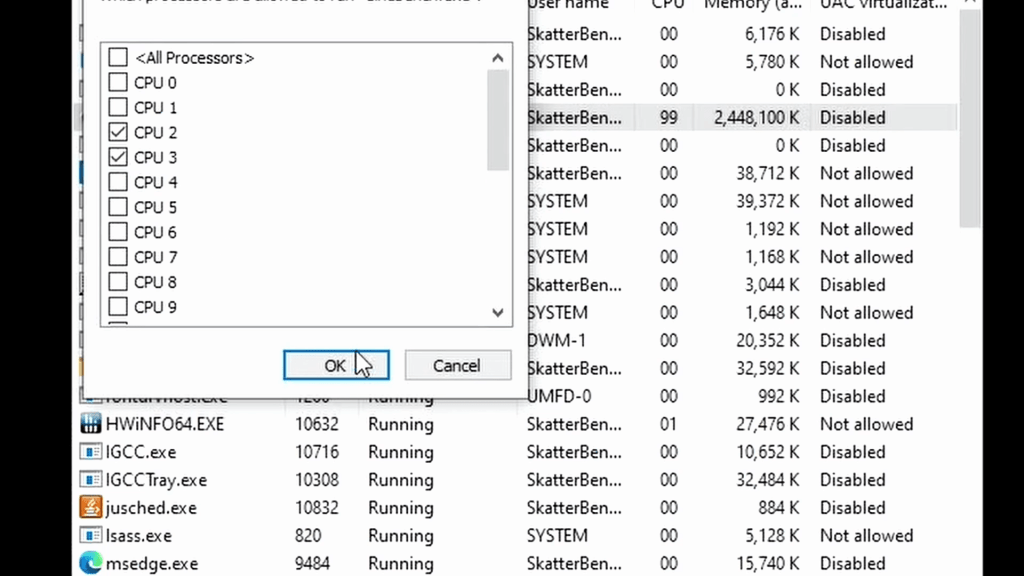

When you reach 4587 MHz or below, check the CPU Core Current reading. This value will be our input for the DOS Current Threshold.
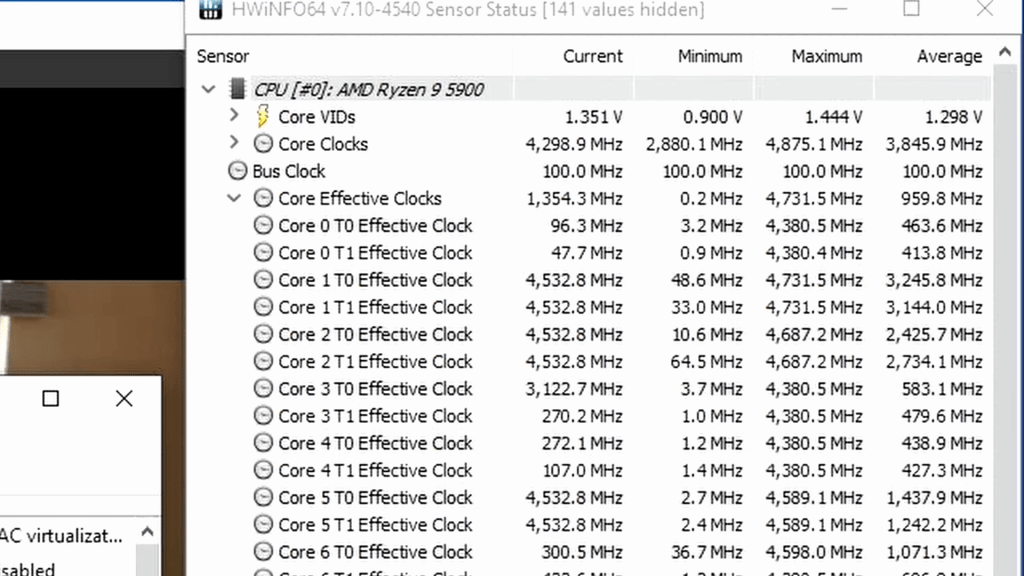

As you can see, I’m not enabling threads sequentially. That’s because as some cores are better than others, they will boost to higher frequencies. So, I want to make sure I am not too conservative when picking the switching point.
I checked which cores are the best by running the CoreCycler application and checking the peak effective clock using HWiNFO.
In our case, we reach the frequency of 4587 MHz at 7 active threads. The current varies between 43.7 and 51.5 amps. To be on the safe side we pick 47A as the Current Threshold.
So, to reiterate what’s happening: Dynamic OC Switcher will switch between OC mode and Precision Boost Overdrive when the CPU current hits 47A. Anything above 47A will engage manual OC mode; anything below 47A will engage Precision Boost Overdrive.
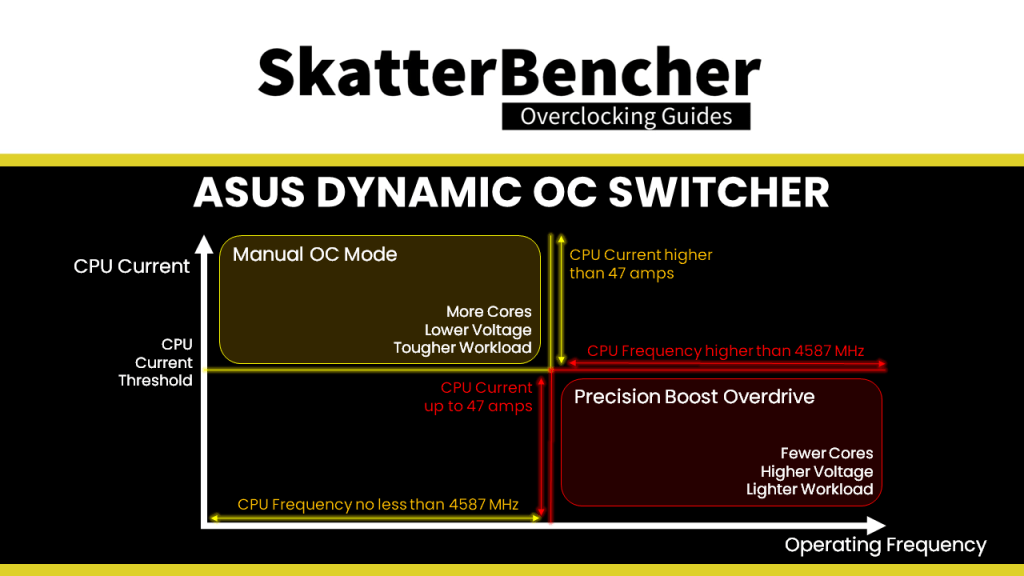
ASUS Dynamic OC Switcher in SkatterBencher Guides
We use ASUS Dynamic OC Switcher in the following SkatterBencher guides:
- SkatterBencher #48: AMD Ryzen 5 7600X Overclocked to 5544 MHz (link)
- SkatterBencher #47: AMD Ryzen 7 7700X Overclocked to 5750 MHz (link)
- SkatterBencher #29: AMD Ryzen 9 5900 B2 Overclocked to 5152 MHz (link)
- SkatterBencher #17: AMD Ryzen 7 5800X Overclocked to 4775 MHz (link)
- SkatterBencher #16: AMD Ryzen 9 5900X Overclocked to 4750 MHz (link)
- SkatterBencher #15: AMD Ryzen 9 5950X Overclocked to 4650 MHz (link)